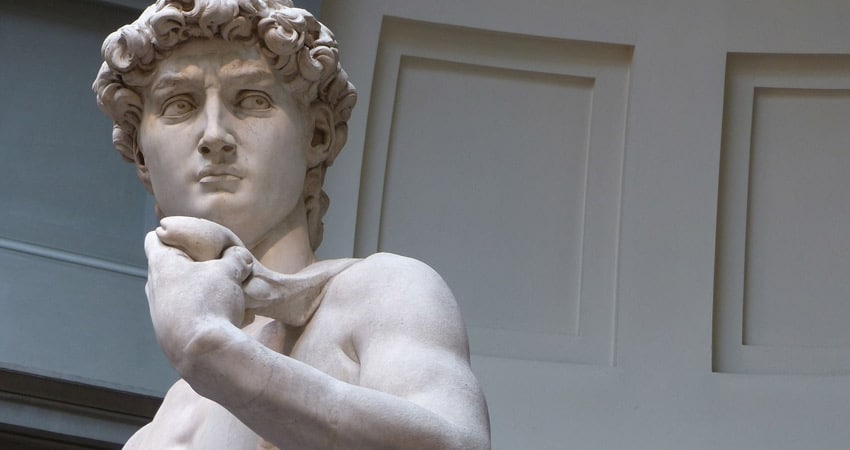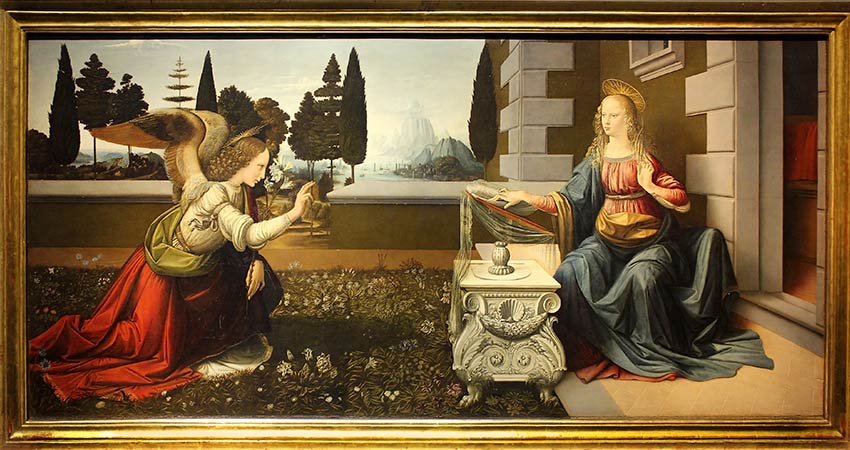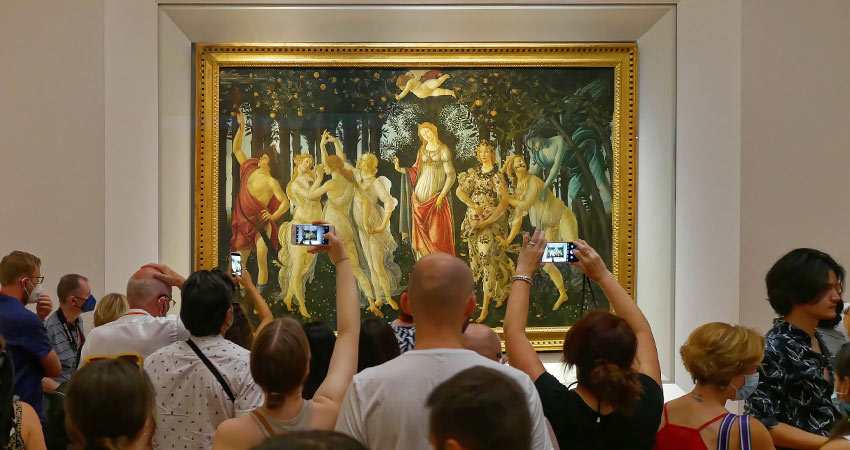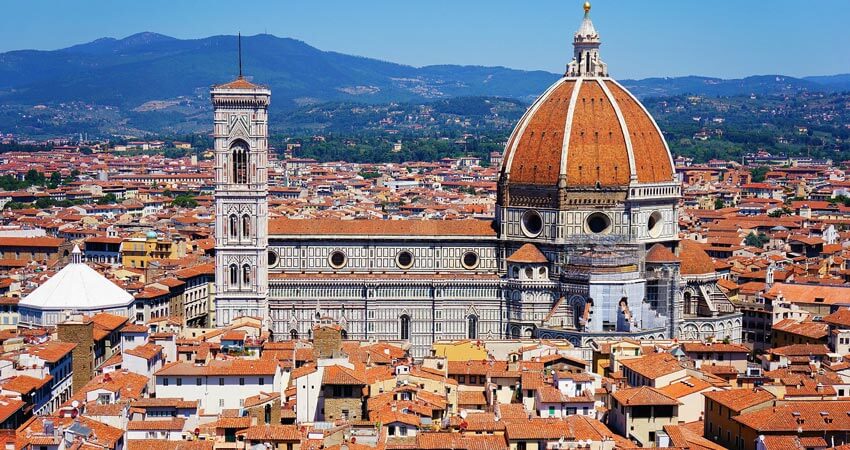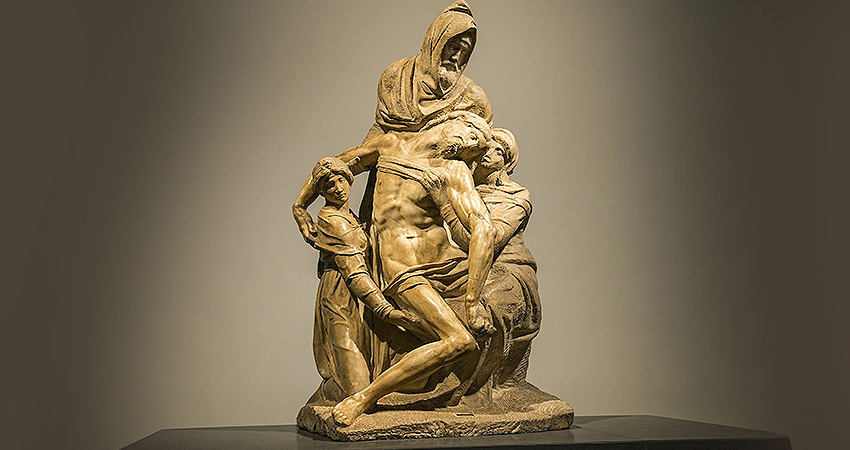Florence, Italy is often called the Cradle of the Renaissance; it represents the rebirth of art and science between the 14th and 17th centuries. The height of the city’s artistic development came in the 15th century when Florence’s prominent banking family, the Medici, devoted terrific sums of money to the talents of Florence’s architects, sculptors, painters, and writers.
Artists flocked to the city. As a result, Florence is a treasure trove of artistic and architectural gems. This is the place to see the defining masterpieces of Renaissance artists such as Michelangelo and Da Vinci. The following six pieces of Italian Renaissance art record the vibrant history of an era that should not be missed by history buffs, art enthusiasts, and curious travelers.
Statue of David
Where to See it: Galleria dell’Accademia
Crafted between the years of 1501 and 1504, Michelangelo’s Statue of David depicts the biblical hero of David before his battle with Goliath, as documented in 1 Samuel 17. David’s eyes exhibit intensity and his body stance display alertness and courage as he enters battle equipped with a sling over his left shoulder and a rock clutched in his right hand, against an armoured Goliath carrying a shield. The block of marble from which David was sculpted had been abandoned for 25 years by two artists prior to Michelangelo because of its imperfections, yet the sheer ingenuity of this Italian sculptor led to the creation of one of the masterpieces that defined the Renaissance.
The Slaves
Where to See it: Galleria dell’Accademia
Standing with the Statue of David at the Galleria dell’Accademia is Michelangelo’s The Slaves. This is a series of four incomplete marble statues named, “The Awakening Slave,” “The Young Slave,” “The Bearded Slave,” and “The Atlas.” (Two completed Slaves are showcased at the Louvre in Paris.) This unfinished work of Michelangelo’s displays his process of sculpting. He believed that his role as sculptor was to free the sculpture inside the block of marble. This is in contrast to sketching guidelines on the marble and carving artwork from the material.
Art historians believe that The Slaves were deliberately incomplete to illustrate the struggles of getting free from trappings of the material world. The strained muscles and powerful stance of the four different slaves show the strength needed to emerge as a free person. These marble sculptures also show Michelangelo’s advanced love and understanding of human anatomy. Michelangelo worked free hand, chiseling his marble without a single guideline… extraordinary. The Slaves are powerful pieces.
Annunciation
Where to See it: Uffizi Gallery
Leonardo da Vinci’s Annunciation, painted in 1472, captures a pivotal moment in Christianity; it is when Angel Gabriel tells Mary that she will be carrying the Son of God, Jesus. Holding a lily, a symbol of virginity, Gabriel is on the left side of the painting. He is met with a look of shock by Mary, on the right.
Mary’s left hand raises as she questions the paternity of Jesus. The mountains and trees in the setting of this painting display da Vinci’s love of nature. A series of analyses suggest that da Vinci worked with Andrea del Verrocchio to complete the Annunciation. Whether or not a follower of the faith, all viewers can appreciate da Vinci’s light brush strokes and elegance, as displayed on the wings of Angel Gabriel.
Primavera
Where to See it: Uffizi Gallery
Also referred to as Allegory of Spring, Sandro Botticelli’s painting displays his skillful use of color in this depiction of spring. Though the exact dates are unclear, it is believed this piece was created in the late 1470s or early 1480s, and was commissioned for a wedding by a member of the Medici family. Botticelli features the Roman goddess Venus in the middle of the painting, framed by the arrival of Cupid above her, and accompanied by the dancing Three Graces to her left. These are symbols of love, chastity, and beauty. The pearls that the Three Graces wear on their heads signify purity.
Mercury is seen in the far left of the painting; he welcomes spring by dispersing clouds with his staff. To the right of Venus, Flora scatters flowers as a symbol of fertility. The arrival of spring is clear in Primavera, as shown by blossoming flowers and fruit trees. Set in an orange grove, the Medici adopted the orange tree as a symbol of their family.
Dome of Florence
Where to See it: Florence Cathedral
Engineered by architectural genius Brunelleschi, construction of the dome began in 1420 when this Italian designer won a public competition held by the Opera del Duomo. At the time of the competition, the city had built the Florence Cathedral, but the Florentines needed a brilliant design to top the structure. Given its incredible size, and challenges in constructing a dome after the cathedral had been built, nobody knew how to do it.
Logically, the dome would have to be supported by scaffolding, but due to the cathedral’s dimensions, scaffolding wasn’t possible. Brunelleschi had to create a design that would support itself while it was being built. He created this octagonal shaped dome to be the largest in the world, drawing inspiration from the shape of the Baptistry across from the Florence Cathedral. A timeless work of art, and designed with no sketches left behind, the complexity and wonder of the Dome still baffles spectators.
The Deposition
Where to See it: Museo dell’Opera del Duomo
The Deposition is one of Michelangelo’s final works of art; it was created in 1547 when he was 72-years-old. It represents Mother Mary and Mary Magdalene, bearing the body of Jesus Christ after his crucifixion. Because this sculpture is housed in the Museo dell’Opera del Duomo, it has earned its title as the Florentine Pieta.
Historians believe the male character, Nicodemus, depicted in The Deposition is actually an image of Michelangelo himself, and that this piece was sculpted for his own tomb. But after spotting a vein in the marble, Michelangelo smashed the sculpture in a fit of rage. The Deposition was found by sculptor Tiberio Calcagni. He restored the work, though Christ’s left leg remains missing.
Florence is extraordinary, and this sophisticated city is a treasure for art lovers. The Medici family poured money into creating wonder. The artists who were attracted to the city’s energy and funding explored new methods of representing ideals of beauty. They used classic and mythic symbols as well as drawing inspiration from the Tuscan countryside. The city’s creativity continues into the present, making it a dream for exploring city streets, galleries, and museums.
If you’re dreaming about a trip to Italy, ask your Destination Expert to include some of the country’s renowned art in your trip.
 My Trips
My Trips 


